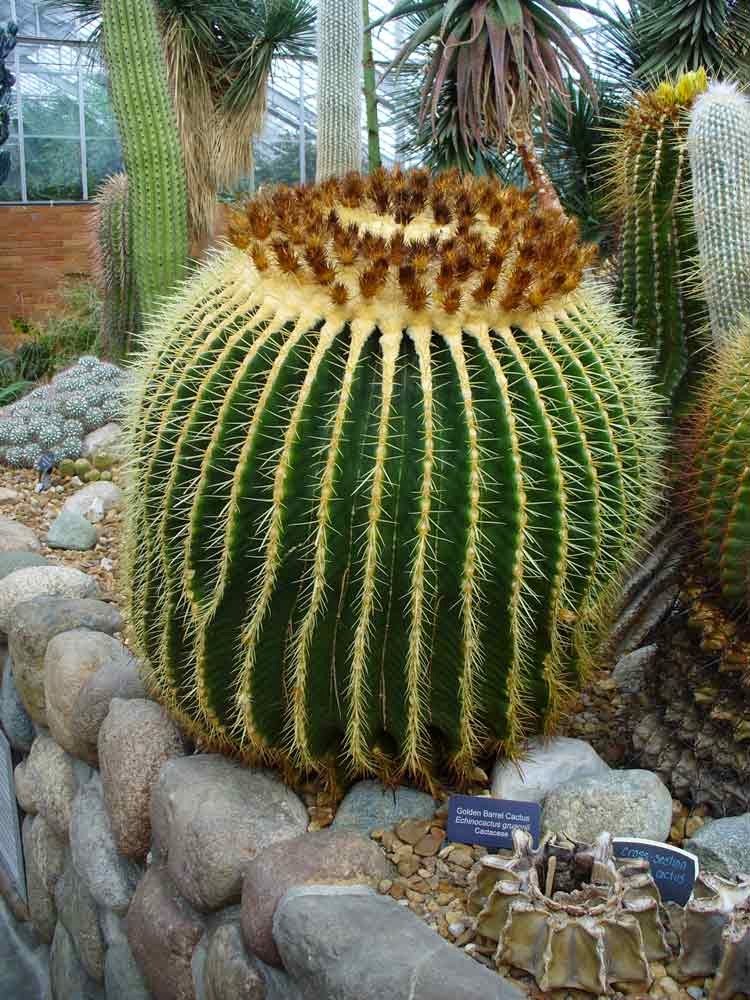.
We have reached the desert room.
The stripey plant is the agave that bloomed last summer. These plants put their all into flowering, once, and then that's it for them. This one is almost done; they are going to take it out soon. The fat green leaves at right are another agave. The stripey one had fat leaves like that, last summer...........
You can see its enormous flower stalk at the top, left of center, and at the left edge of the image, you see a pedestal with a plexiglas box protecting new baby agaves.
More info about the plant. They were expecting there would be "pups" -- clones of the mother plant, sprouting around its base, but no.
There were, however, hundreds and hundreds of seeds. Here are the first of the baby agaves, planted December 1, growing inside that plexiglas box. A sign said that only the seeds in the black coats (still seen here on the tips of the plants) are viable, and that only about 5% of the seeds were viable.
Here's what the seed pods look like, when split, and we can see a lot of pale (non-viable) seeds, along with a few black ones.
Here's a look at what's left of the flower stalk. It's 5-6" in diameter, I think. It was taller than the roof of the conservatory. They removed glass, last summer, so it could get as tall as it wanted. When the weather got cold, they removed the top several feet, so they could close the roof.
What a spectacular plant.
You can see the flower stalk of the big stripey agave, top center in the next image....
This plant is a barrel cactus.
Closer crop of the above -- a cross-section of a barrel cactus, so we can see what they look like inside.
And here's the top of the barrel cactus. I don't know if these are going to be flowers, or if they were flowers, or if they don't have anything to do with flowers..... I wonder if all of that fuzzy stuff has teeny little stickers that would make me regret touching it.....
I am careful not to touch the plants in the conservatory. I learned, in What a Plant Knows (a terrific class!), that plants know when they are touched, and it is not a happy sensation for them. There is no loving touch, in the plant world. Touch means danger; touch means imminent damage..... So I don't touch plants which are in special collections, just as I don't touch objects in museums. Every touch is harm.........
I am especially careful not to touch any plants, even inadvertently, in the desert room. I don't want to learn about their defenses against harm in an up-close and personal way. Reading, yes. Itching for weeks (and/or having to pull out hooked spines) -- no!
Here's something much smaller, which is blooming! (And, speaking of hooked spines.......)
Hen and chicks. GREEN, even in the desert.
This is my favorite plant in the conservatory. It's another agave. I think the sign said it is a blue agave. It is much smaller -- the whole plant isn't much more than 18" tall, I think.
I love the red spikes, and the marks of spikes on the surfaces of the leaves.
I've talked, before, about the way leaves seem to have their full leaf identity the moment they are born. New baby leaves seem to be recognizable as leaves of their kind, right from their very beginning.
The leaves of this agave come wrapped in a very tight cone. As they mature, they fill up and pull away from the cone. They keep the marks of the spikes of their older-sister leaves on their outer surfaces, and the marks of the spikes of their younger-sister leaves on their inner surfaces. For their whole existence.
Here's a closer look at the above. Notice the square-ish mark on the right-hand leaf, near the bottom. Then look at the cone -- you can see the square-ish structure that left that mark. Then note the four spikes on the cone, above that "square," and you will see the four marks they left, on the right-hand leaf.....
There are several of these little agaves at the gardens. Here's another plant, with a leaf that has more recently pulled away from the central cone-of-new-leaves....
One of these agaves bloomed last summer, too. It was a little ahead of the giant stripey one. The leaves of the two kinds of agave look very different, but the flower stalks looked verrrry similar.
This agave has completed its life cycle.
Notice how the marks the spikes of other leaves have left on these leaves are still very visible, even after the whole plant is dead.
What a cool plant.
Moving on -- flowers! That tree-shaped plant, with the "hands" of leaves, is producing all of those orange flowers. It's one of my favorites, too. I hope flowering doesn't mark the end of its life.
A closer look at its flowers. (Note flower stalk of big agave behind, upper left corner.)
Here's one of its leaf "hands." I guess these really don't look much like hands. But aren't they cool? (I have to note they look a bit shriveled. I don't know if that may be seasonal, or if it's an indication the plant is on its way out.)
A much tinier plant, also blooming.
Another blooming plant. I'm noticing a lot of similar colors in flowers. I wonder if that is a coincidence, or if desert pollinators often can see red/orange across a distance.
GREEN.
And orange!
The end of this one looks healthy, but the rest of it is more shriveled. I wonder if it's supposed to be lying on the ground.
I wonder if this one blooms all the time. It was blooming when we were here last summer.
One last glimpse of the top of the big agave's flower stalk, and a look at some of its neighbors.
When I took a closer look at these flowers (on the "big screen"), I decided they were spent. I wonder what kind of plant this is? It's very tall (for a plant growing in a conservatory).
.
Subscribe to:
Post Comments (Atom)















































No comments:
Post a Comment